Total Quality Management Report: History, Trends, and Implementation
VerifiedAdded on 2019/09/23
|18
|5831
|202
Report
AI Summary
This report provides a comprehensive overview of Total Quality Management (TQM), tracing its historical development from the 1950s to its widespread adoption in the 1980s. It defines TQM as a management approach focused on continuous improvement in production and customer satisfaction. The report delves into the trends of TQM over the past decade, highlighting the shift towards tools like Six Sigma and ERP, while emphasizing the core principles of TQM, such as leadership, employee awareness, open communication, and customer focus. It explores the implementation process, including the need for leadership commitment and a focus on continuous improvement. The report also examines real-world examples of TQM in action and identifies barriers to its effective implementation. The overall conclusion underscores the significance of TQM for future business success, particularly in adapting to rapid technological changes and ensuring consistent product quality.
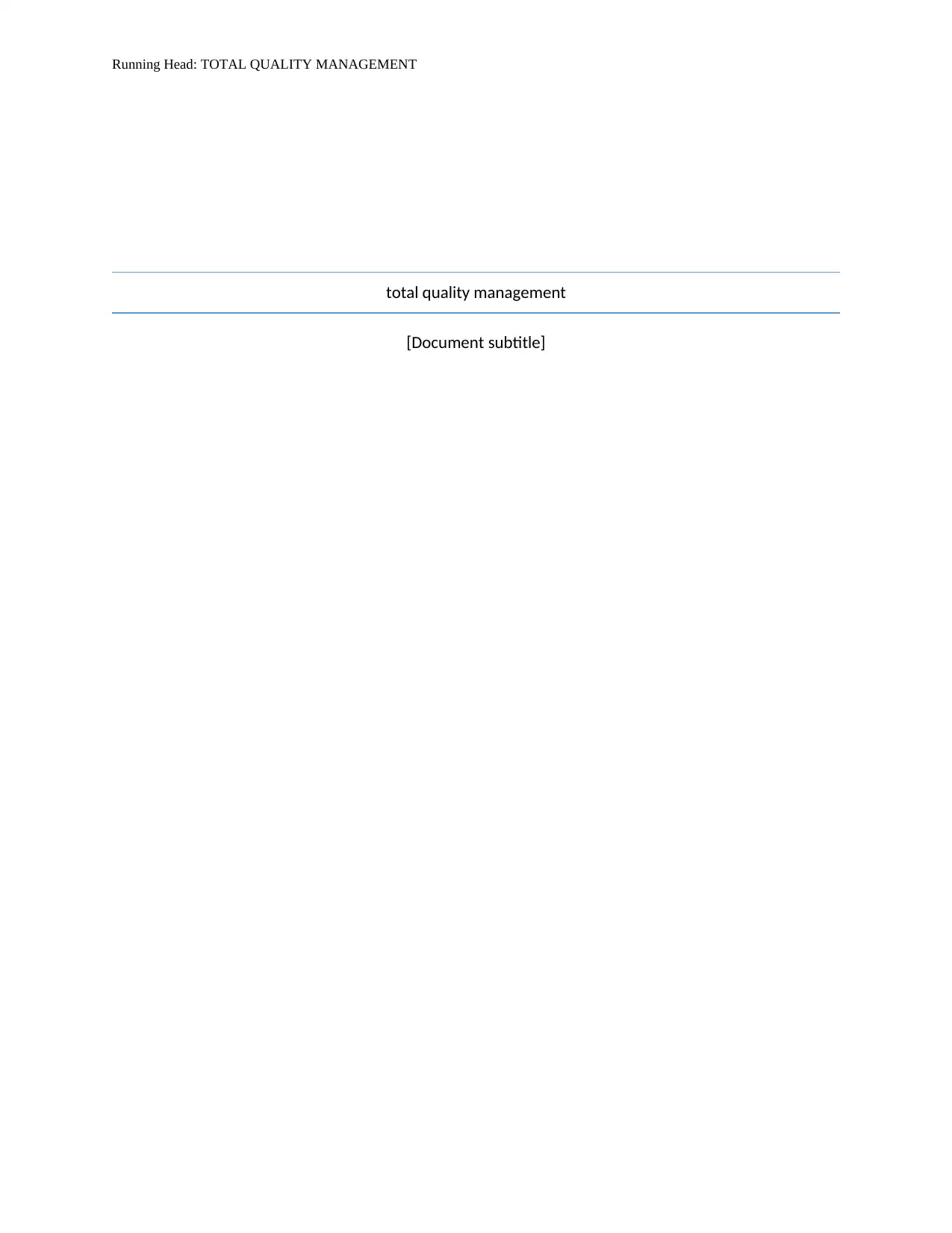
Running Head: TOTAL QUALITY MANAGEMENT
total quality management
[Document subtitle]
total quality management
[Document subtitle]
Paraphrase This Document
Need a fresh take? Get an instant paraphrase of this document with our AI Paraphraser
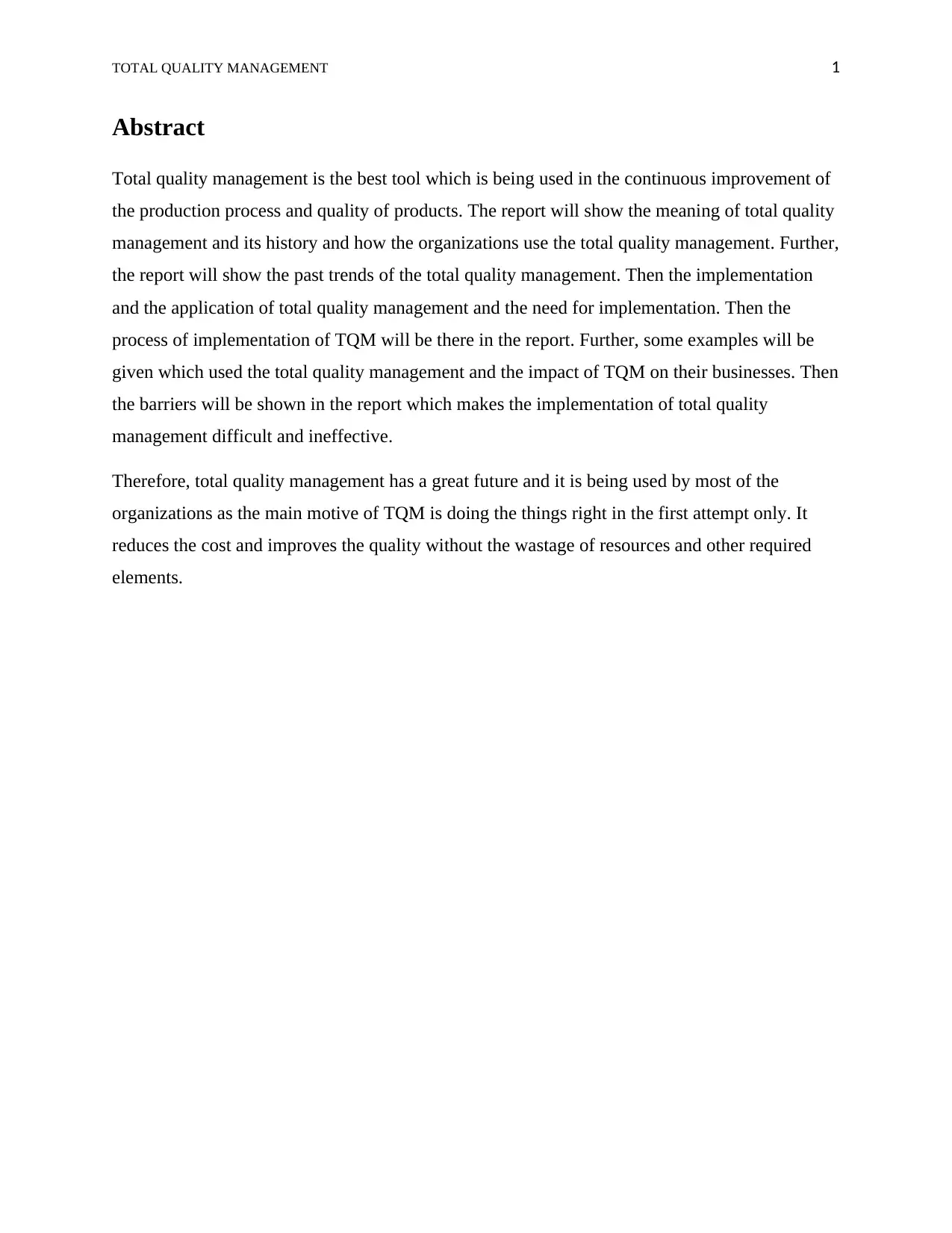
TOTAL QUALITY MANAGEMENT 1
Abstract
Total quality management is the best tool which is being used in the continuous improvement of
the production process and quality of products. The report will show the meaning of total quality
management and its history and how the organizations use the total quality management. Further,
the report will show the past trends of the total quality management. Then the implementation
and the application of total quality management and the need for implementation. Then the
process of implementation of TQM will be there in the report. Further, some examples will be
given which used the total quality management and the impact of TQM on their businesses. Then
the barriers will be shown in the report which makes the implementation of total quality
management difficult and ineffective.
Therefore, total quality management has a great future and it is being used by most of the
organizations as the main motive of TQM is doing the things right in the first attempt only. It
reduces the cost and improves the quality without the wastage of resources and other required
elements.
Abstract
Total quality management is the best tool which is being used in the continuous improvement of
the production process and quality of products. The report will show the meaning of total quality
management and its history and how the organizations use the total quality management. Further,
the report will show the past trends of the total quality management. Then the implementation
and the application of total quality management and the need for implementation. Then the
process of implementation of TQM will be there in the report. Further, some examples will be
given which used the total quality management and the impact of TQM on their businesses. Then
the barriers will be shown in the report which makes the implementation of total quality
management difficult and ineffective.
Therefore, total quality management has a great future and it is being used by most of the
organizations as the main motive of TQM is doing the things right in the first attempt only. It
reduces the cost and improves the quality without the wastage of resources and other required
elements.
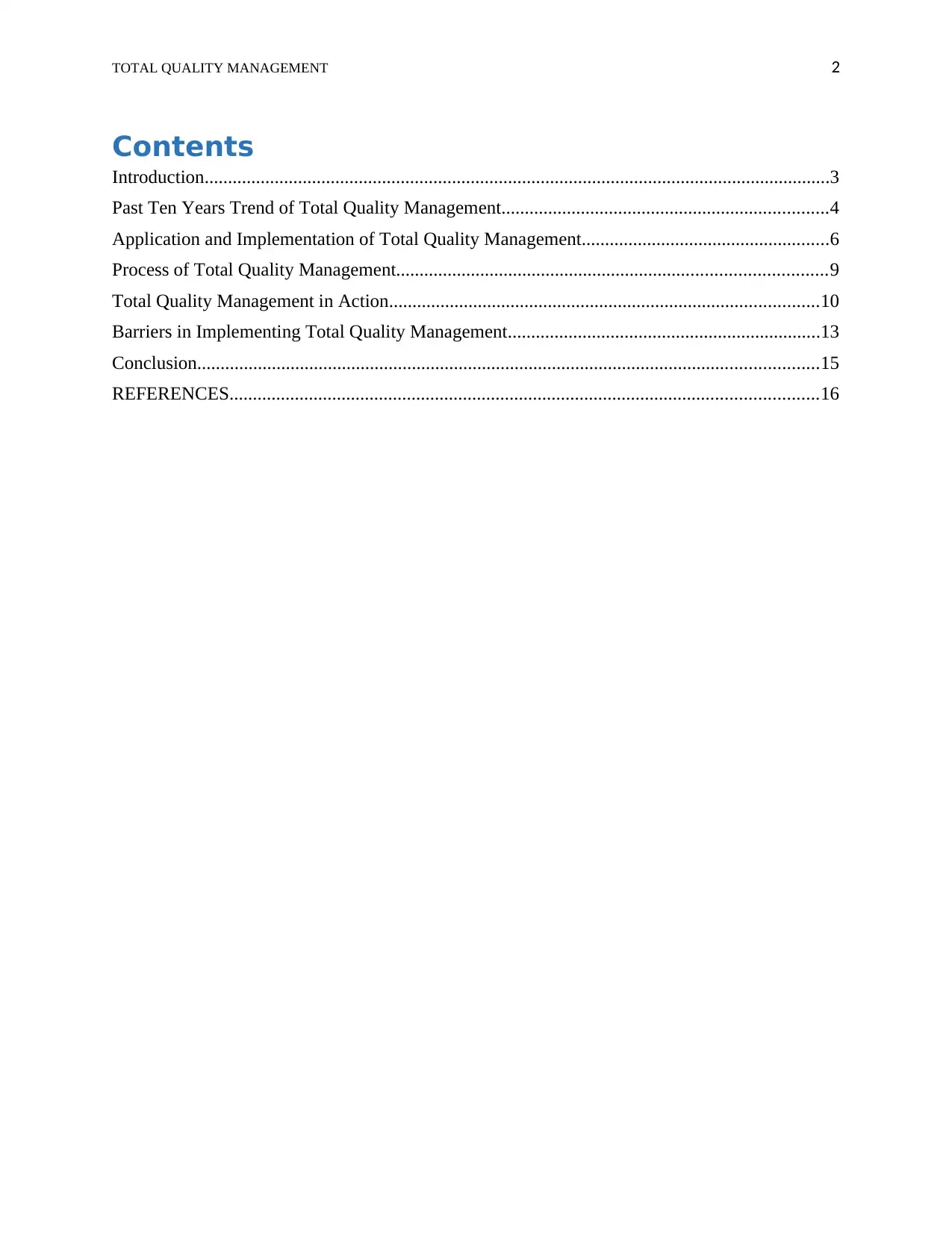
TOTAL QUALITY MANAGEMENT 2
Contents
Introduction......................................................................................................................................3
Past Ten Years Trend of Total Quality Management......................................................................4
Application and Implementation of Total Quality Management.....................................................6
Process of Total Quality Management............................................................................................9
Total Quality Management in Action............................................................................................10
Barriers in Implementing Total Quality Management...................................................................13
Conclusion.....................................................................................................................................15
REFERENCES..............................................................................................................................16
Contents
Introduction......................................................................................................................................3
Past Ten Years Trend of Total Quality Management......................................................................4
Application and Implementation of Total Quality Management.....................................................6
Process of Total Quality Management............................................................................................9
Total Quality Management in Action............................................................................................10
Barriers in Implementing Total Quality Management...................................................................13
Conclusion.....................................................................................................................................15
REFERENCES..............................................................................................................................16
⊘ This is a preview!⊘
Do you want full access?
Subscribe today to unlock all pages.

Trusted by 1+ million students worldwide
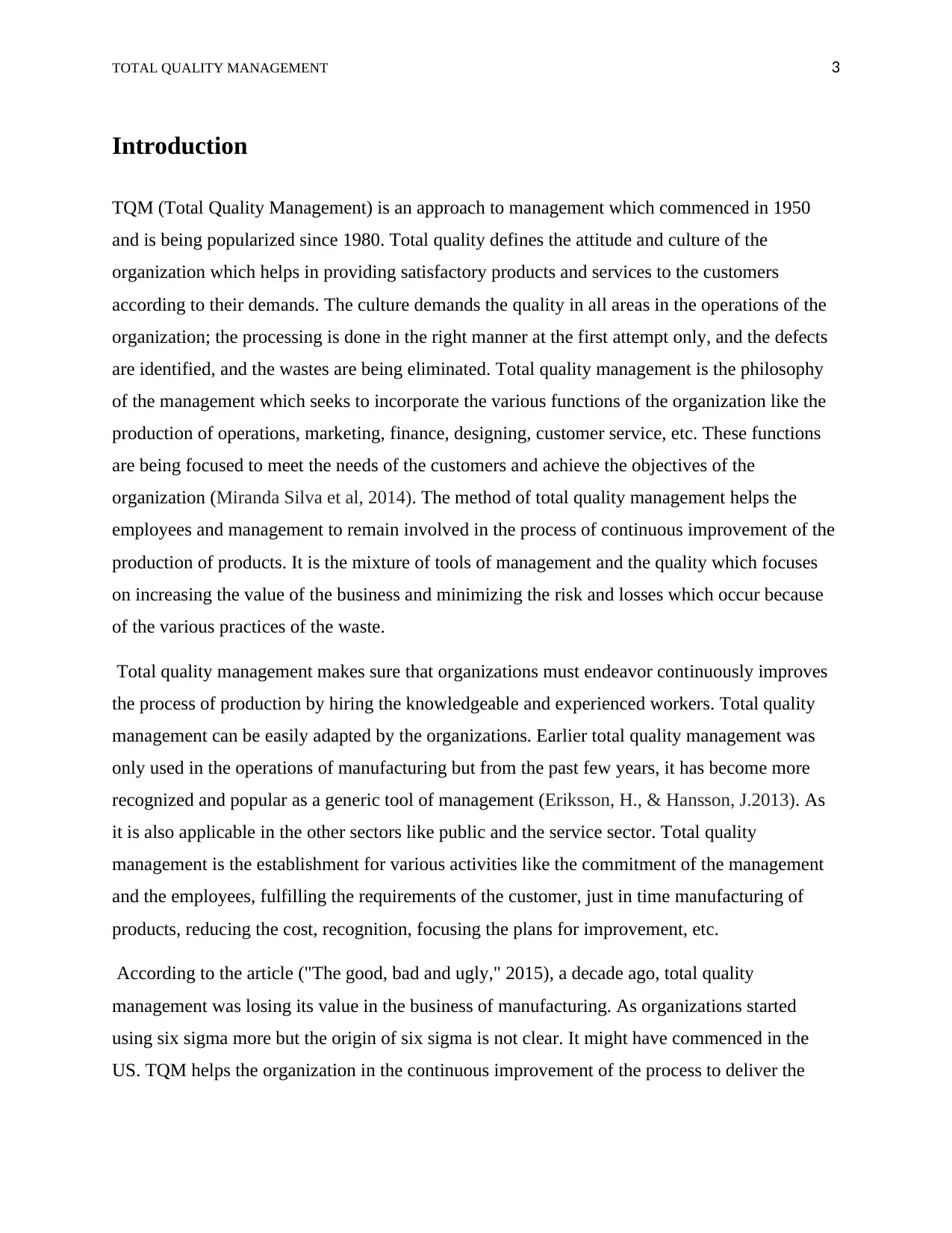
TOTAL QUALITY MANAGEMENT 3
Introduction
TQM (Total Quality Management) is an approach to management which commenced in 1950
and is being popularized since 1980. Total quality defines the attitude and culture of the
organization which helps in providing satisfactory products and services to the customers
according to their demands. The culture demands the quality in all areas in the operations of the
organization; the processing is done in the right manner at the first attempt only, and the defects
are identified, and the wastes are being eliminated. Total quality management is the philosophy
of the management which seeks to incorporate the various functions of the organization like the
production of operations, marketing, finance, designing, customer service, etc. These functions
are being focused to meet the needs of the customers and achieve the objectives of the
organization (Miranda Silva et al, 2014). The method of total quality management helps the
employees and management to remain involved in the process of continuous improvement of the
production of products. It is the mixture of tools of management and the quality which focuses
on increasing the value of the business and minimizing the risk and losses which occur because
of the various practices of the waste.
Total quality management makes sure that organizations must endeavor continuously improves
the process of production by hiring the knowledgeable and experienced workers. Total quality
management can be easily adapted by the organizations. Earlier total quality management was
only used in the operations of manufacturing but from the past few years, it has become more
recognized and popular as a generic tool of management (Eriksson, H., & Hansson, J.2013). As
it is also applicable in the other sectors like public and the service sector. Total quality
management is the establishment for various activities like the commitment of the management
and the employees, fulfilling the requirements of the customer, just in time manufacturing of
products, reducing the cost, recognition, focusing the plans for improvement, etc.
According to the article ("The good, bad and ugly," 2015), a decade ago, total quality
management was losing its value in the business of manufacturing. As organizations started
using six sigma more but the origin of six sigma is not clear. It might have commenced in the
US. TQM helps the organization in the continuous improvement of the process to deliver the
Introduction
TQM (Total Quality Management) is an approach to management which commenced in 1950
and is being popularized since 1980. Total quality defines the attitude and culture of the
organization which helps in providing satisfactory products and services to the customers
according to their demands. The culture demands the quality in all areas in the operations of the
organization; the processing is done in the right manner at the first attempt only, and the defects
are identified, and the wastes are being eliminated. Total quality management is the philosophy
of the management which seeks to incorporate the various functions of the organization like the
production of operations, marketing, finance, designing, customer service, etc. These functions
are being focused to meet the needs of the customers and achieve the objectives of the
organization (Miranda Silva et al, 2014). The method of total quality management helps the
employees and management to remain involved in the process of continuous improvement of the
production of products. It is the mixture of tools of management and the quality which focuses
on increasing the value of the business and minimizing the risk and losses which occur because
of the various practices of the waste.
Total quality management makes sure that organizations must endeavor continuously improves
the process of production by hiring the knowledgeable and experienced workers. Total quality
management can be easily adapted by the organizations. Earlier total quality management was
only used in the operations of manufacturing but from the past few years, it has become more
recognized and popular as a generic tool of management (Eriksson, H., & Hansson, J.2013). As
it is also applicable in the other sectors like public and the service sector. Total quality
management is the establishment for various activities like the commitment of the management
and the employees, fulfilling the requirements of the customer, just in time manufacturing of
products, reducing the cost, recognition, focusing the plans for improvement, etc.
According to the article ("The good, bad and ugly," 2015), a decade ago, total quality
management was losing its value in the business of manufacturing. As organizations started
using six sigma more but the origin of six sigma is not clear. It might have commenced in the
US. TQM helps the organization in the continuous improvement of the process to deliver the
Paraphrase This Document
Need a fresh take? Get an instant paraphrase of this document with our AI Paraphraser
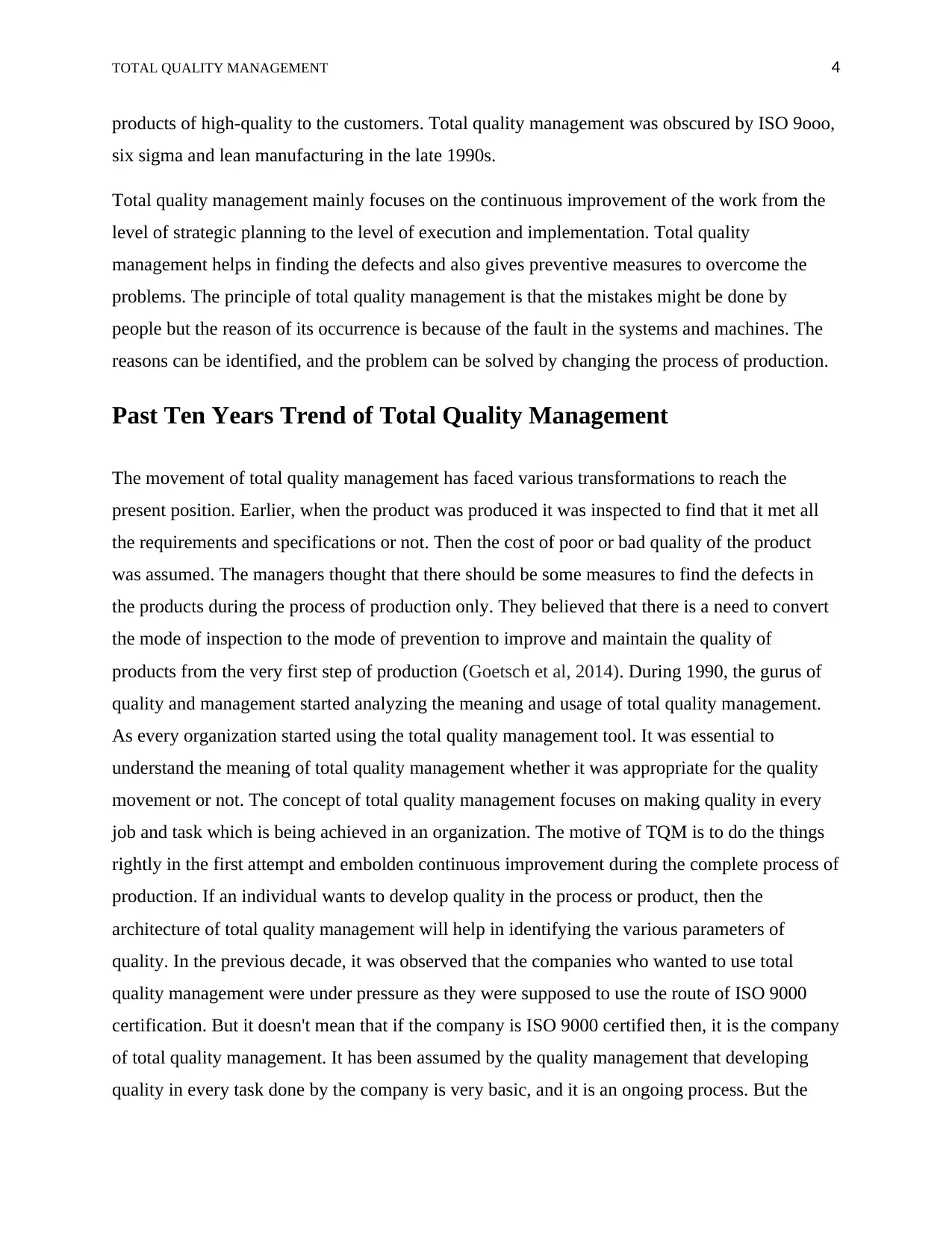
TOTAL QUALITY MANAGEMENT 4
products of high-quality to the customers. Total quality management was obscured by ISO 9ooo,
six sigma and lean manufacturing in the late 1990s.
Total quality management mainly focuses on the continuous improvement of the work from the
level of strategic planning to the level of execution and implementation. Total quality
management helps in finding the defects and also gives preventive measures to overcome the
problems. The principle of total quality management is that the mistakes might be done by
people but the reason of its occurrence is because of the fault in the systems and machines. The
reasons can be identified, and the problem can be solved by changing the process of production.
Past Ten Years Trend of Total Quality Management
The movement of total quality management has faced various transformations to reach the
present position. Earlier, when the product was produced it was inspected to find that it met all
the requirements and specifications or not. Then the cost of poor or bad quality of the product
was assumed. The managers thought that there should be some measures to find the defects in
the products during the process of production only. They believed that there is a need to convert
the mode of inspection to the mode of prevention to improve and maintain the quality of
products from the very first step of production (Goetsch et al, 2014). During 1990, the gurus of
quality and management started analyzing the meaning and usage of total quality management.
As every organization started using the total quality management tool. It was essential to
understand the meaning of total quality management whether it was appropriate for the quality
movement or not. The concept of total quality management focuses on making quality in every
job and task which is being achieved in an organization. The motive of TQM is to do the things
rightly in the first attempt and embolden continuous improvement during the complete process of
production. If an individual wants to develop quality in the process or product, then the
architecture of total quality management will help in identifying the various parameters of
quality. In the previous decade, it was observed that the companies who wanted to use total
quality management were under pressure as they were supposed to use the route of ISO 9000
certification. But it doesn't mean that if the company is ISO 9000 certified then, it is the company
of total quality management. It has been assumed by the quality management that developing
quality in every task done by the company is very basic, and it is an ongoing process. But the
products of high-quality to the customers. Total quality management was obscured by ISO 9ooo,
six sigma and lean manufacturing in the late 1990s.
Total quality management mainly focuses on the continuous improvement of the work from the
level of strategic planning to the level of execution and implementation. Total quality
management helps in finding the defects and also gives preventive measures to overcome the
problems. The principle of total quality management is that the mistakes might be done by
people but the reason of its occurrence is because of the fault in the systems and machines. The
reasons can be identified, and the problem can be solved by changing the process of production.
Past Ten Years Trend of Total Quality Management
The movement of total quality management has faced various transformations to reach the
present position. Earlier, when the product was produced it was inspected to find that it met all
the requirements and specifications or not. Then the cost of poor or bad quality of the product
was assumed. The managers thought that there should be some measures to find the defects in
the products during the process of production only. They believed that there is a need to convert
the mode of inspection to the mode of prevention to improve and maintain the quality of
products from the very first step of production (Goetsch et al, 2014). During 1990, the gurus of
quality and management started analyzing the meaning and usage of total quality management.
As every organization started using the total quality management tool. It was essential to
understand the meaning of total quality management whether it was appropriate for the quality
movement or not. The concept of total quality management focuses on making quality in every
job and task which is being achieved in an organization. The motive of TQM is to do the things
rightly in the first attempt and embolden continuous improvement during the complete process of
production. If an individual wants to develop quality in the process or product, then the
architecture of total quality management will help in identifying the various parameters of
quality. In the previous decade, it was observed that the companies who wanted to use total
quality management were under pressure as they were supposed to use the route of ISO 9000
certification. But it doesn't mean that if the company is ISO 9000 certified then, it is the company
of total quality management. It has been assumed by the quality management that developing
quality in every task done by the company is very basic, and it is an ongoing process. But the
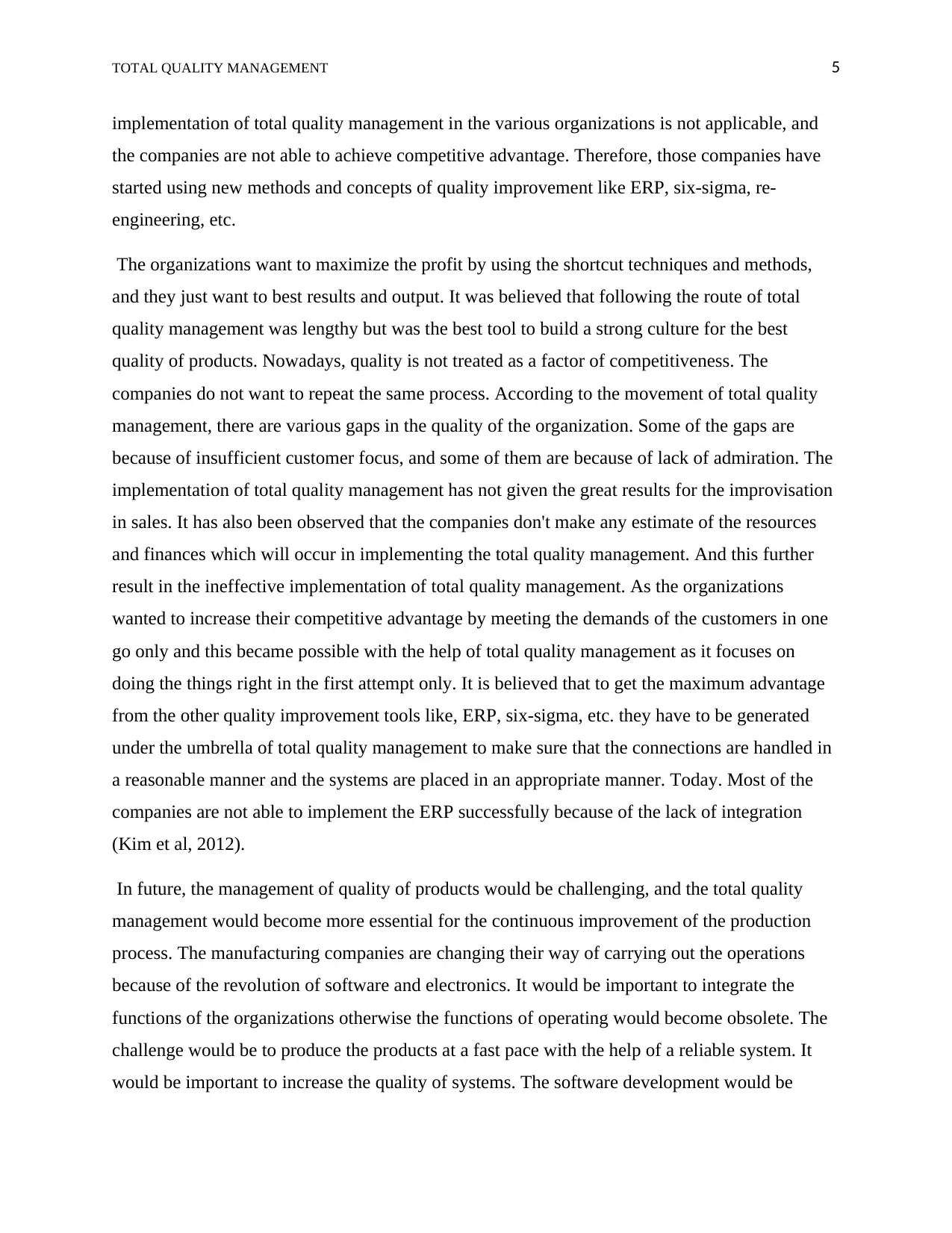
TOTAL QUALITY MANAGEMENT 5
implementation of total quality management in the various organizations is not applicable, and
the companies are not able to achieve competitive advantage. Therefore, those companies have
started using new methods and concepts of quality improvement like ERP, six-sigma, re-
engineering, etc.
The organizations want to maximize the profit by using the shortcut techniques and methods,
and they just want to best results and output. It was believed that following the route of total
quality management was lengthy but was the best tool to build a strong culture for the best
quality of products. Nowadays, quality is not treated as a factor of competitiveness. The
companies do not want to repeat the same process. According to the movement of total quality
management, there are various gaps in the quality of the organization. Some of the gaps are
because of insufficient customer focus, and some of them are because of lack of admiration. The
implementation of total quality management has not given the great results for the improvisation
in sales. It has also been observed that the companies don't make any estimate of the resources
and finances which will occur in implementing the total quality management. And this further
result in the ineffective implementation of total quality management. As the organizations
wanted to increase their competitive advantage by meeting the demands of the customers in one
go only and this became possible with the help of total quality management as it focuses on
doing the things right in the first attempt only. It is believed that to get the maximum advantage
from the other quality improvement tools like, ERP, six-sigma, etc. they have to be generated
under the umbrella of total quality management to make sure that the connections are handled in
a reasonable manner and the systems are placed in an appropriate manner. Today. Most of the
companies are not able to implement the ERP successfully because of the lack of integration
(Kim et al, 2012).
In future, the management of quality of products would be challenging, and the total quality
management would become more essential for the continuous improvement of the production
process. The manufacturing companies are changing their way of carrying out the operations
because of the revolution of software and electronics. It would be important to integrate the
functions of the organizations otherwise the functions of operating would become obsolete. The
challenge would be to produce the products at a fast pace with the help of a reliable system. It
would be important to increase the quality of systems. The software development would be
implementation of total quality management in the various organizations is not applicable, and
the companies are not able to achieve competitive advantage. Therefore, those companies have
started using new methods and concepts of quality improvement like ERP, six-sigma, re-
engineering, etc.
The organizations want to maximize the profit by using the shortcut techniques and methods,
and they just want to best results and output. It was believed that following the route of total
quality management was lengthy but was the best tool to build a strong culture for the best
quality of products. Nowadays, quality is not treated as a factor of competitiveness. The
companies do not want to repeat the same process. According to the movement of total quality
management, there are various gaps in the quality of the organization. Some of the gaps are
because of insufficient customer focus, and some of them are because of lack of admiration. The
implementation of total quality management has not given the great results for the improvisation
in sales. It has also been observed that the companies don't make any estimate of the resources
and finances which will occur in implementing the total quality management. And this further
result in the ineffective implementation of total quality management. As the organizations
wanted to increase their competitive advantage by meeting the demands of the customers in one
go only and this became possible with the help of total quality management as it focuses on
doing the things right in the first attempt only. It is believed that to get the maximum advantage
from the other quality improvement tools like, ERP, six-sigma, etc. they have to be generated
under the umbrella of total quality management to make sure that the connections are handled in
a reasonable manner and the systems are placed in an appropriate manner. Today. Most of the
companies are not able to implement the ERP successfully because of the lack of integration
(Kim et al, 2012).
In future, the management of quality of products would be challenging, and the total quality
management would become more essential for the continuous improvement of the production
process. The manufacturing companies are changing their way of carrying out the operations
because of the revolution of software and electronics. It would be important to integrate the
functions of the organizations otherwise the functions of operating would become obsolete. The
challenge would be to produce the products at a fast pace with the help of a reliable system. It
would be important to increase the quality of systems. The software development would be
⊘ This is a preview!⊘
Do you want full access?
Subscribe today to unlock all pages.

Trusted by 1+ million students worldwide
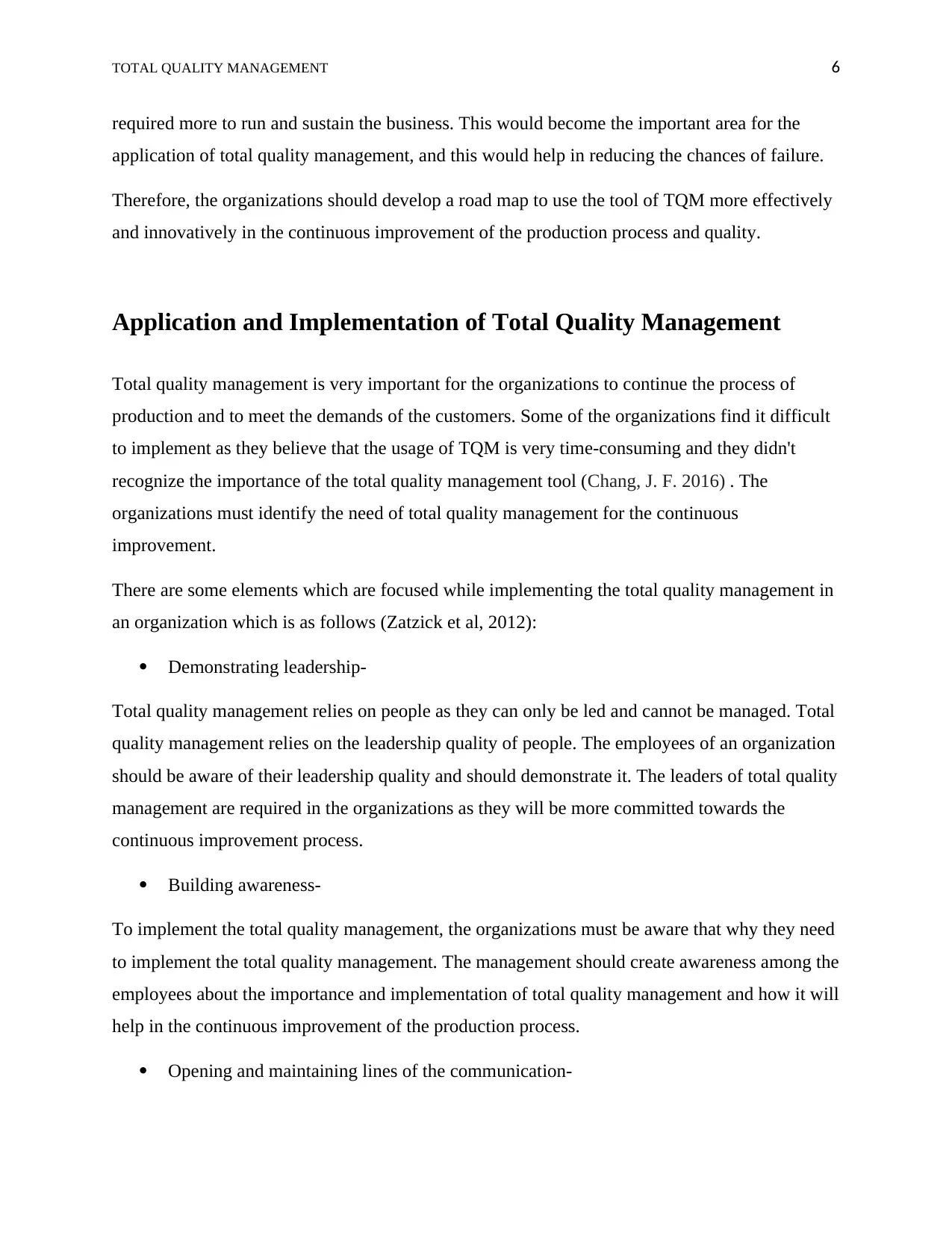
TOTAL QUALITY MANAGEMENT 6
required more to run and sustain the business. This would become the important area for the
application of total quality management, and this would help in reducing the chances of failure.
Therefore, the organizations should develop a road map to use the tool of TQM more effectively
and innovatively in the continuous improvement of the production process and quality.
Application and Implementation of Total Quality Management
Total quality management is very important for the organizations to continue the process of
production and to meet the demands of the customers. Some of the organizations find it difficult
to implement as they believe that the usage of TQM is very time-consuming and they didn't
recognize the importance of the total quality management tool (Chang, J. F. 2016) . The
organizations must identify the need of total quality management for the continuous
improvement.
There are some elements which are focused while implementing the total quality management in
an organization which is as follows (Zatzick et al, 2012):
Demonstrating leadership-
Total quality management relies on people as they can only be led and cannot be managed. Total
quality management relies on the leadership quality of people. The employees of an organization
should be aware of their leadership quality and should demonstrate it. The leaders of total quality
management are required in the organizations as they will be more committed towards the
continuous improvement process.
Building awareness-
To implement the total quality management, the organizations must be aware that why they need
to implement the total quality management. The management should create awareness among the
employees about the importance and implementation of total quality management and how it will
help in the continuous improvement of the production process.
Opening and maintaining lines of the communication-
required more to run and sustain the business. This would become the important area for the
application of total quality management, and this would help in reducing the chances of failure.
Therefore, the organizations should develop a road map to use the tool of TQM more effectively
and innovatively in the continuous improvement of the production process and quality.
Application and Implementation of Total Quality Management
Total quality management is very important for the organizations to continue the process of
production and to meet the demands of the customers. Some of the organizations find it difficult
to implement as they believe that the usage of TQM is very time-consuming and they didn't
recognize the importance of the total quality management tool (Chang, J. F. 2016) . The
organizations must identify the need of total quality management for the continuous
improvement.
There are some elements which are focused while implementing the total quality management in
an organization which is as follows (Zatzick et al, 2012):
Demonstrating leadership-
Total quality management relies on people as they can only be led and cannot be managed. Total
quality management relies on the leadership quality of people. The employees of an organization
should be aware of their leadership quality and should demonstrate it. The leaders of total quality
management are required in the organizations as they will be more committed towards the
continuous improvement process.
Building awareness-
To implement the total quality management, the organizations must be aware that why they need
to implement the total quality management. The management should create awareness among the
employees about the importance and implementation of total quality management and how it will
help in the continuous improvement of the production process.
Opening and maintaining lines of the communication-
Paraphrase This Document
Need a fresh take? Get an instant paraphrase of this document with our AI Paraphraser
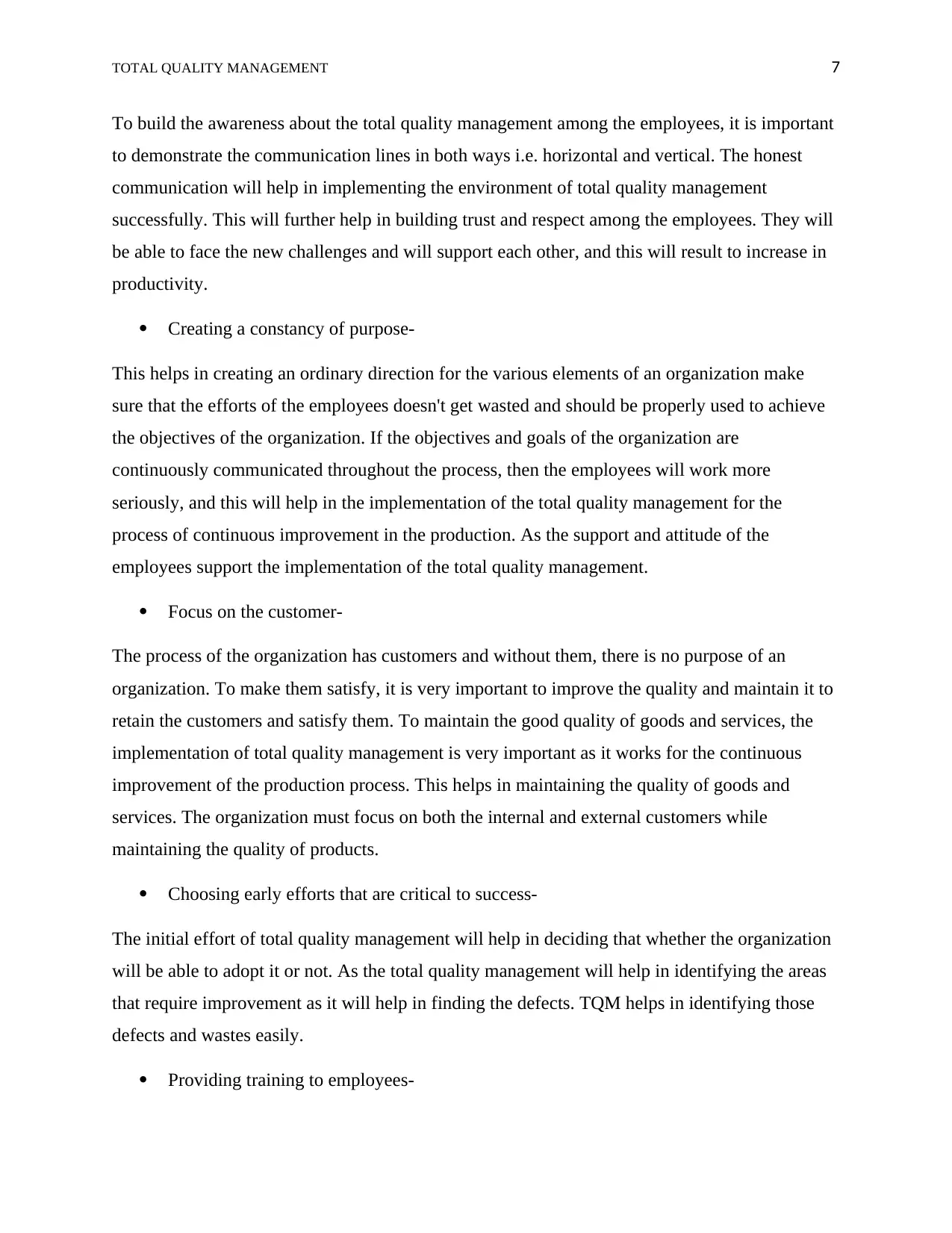
TOTAL QUALITY MANAGEMENT 7
To build the awareness about the total quality management among the employees, it is important
to demonstrate the communication lines in both ways i.e. horizontal and vertical. The honest
communication will help in implementing the environment of total quality management
successfully. This will further help in building trust and respect among the employees. They will
be able to face the new challenges and will support each other, and this will result to increase in
productivity.
Creating a constancy of purpose-
This helps in creating an ordinary direction for the various elements of an organization make
sure that the efforts of the employees doesn't get wasted and should be properly used to achieve
the objectives of the organization. If the objectives and goals of the organization are
continuously communicated throughout the process, then the employees will work more
seriously, and this will help in the implementation of the total quality management for the
process of continuous improvement in the production. As the support and attitude of the
employees support the implementation of the total quality management.
Focus on the customer-
The process of the organization has customers and without them, there is no purpose of an
organization. To make them satisfy, it is very important to improve the quality and maintain it to
retain the customers and satisfy them. To maintain the good quality of goods and services, the
implementation of total quality management is very important as it works for the continuous
improvement of the production process. This helps in maintaining the quality of goods and
services. The organization must focus on both the internal and external customers while
maintaining the quality of products.
Choosing early efforts that are critical to success-
The initial effort of total quality management will help in deciding that whether the organization
will be able to adopt it or not. As the total quality management will help in identifying the areas
that require improvement as it will help in finding the defects. TQM helps in identifying those
defects and wastes easily.
Providing training to employees-
To build the awareness about the total quality management among the employees, it is important
to demonstrate the communication lines in both ways i.e. horizontal and vertical. The honest
communication will help in implementing the environment of total quality management
successfully. This will further help in building trust and respect among the employees. They will
be able to face the new challenges and will support each other, and this will result to increase in
productivity.
Creating a constancy of purpose-
This helps in creating an ordinary direction for the various elements of an organization make
sure that the efforts of the employees doesn't get wasted and should be properly used to achieve
the objectives of the organization. If the objectives and goals of the organization are
continuously communicated throughout the process, then the employees will work more
seriously, and this will help in the implementation of the total quality management for the
process of continuous improvement in the production. As the support and attitude of the
employees support the implementation of the total quality management.
Focus on the customer-
The process of the organization has customers and without them, there is no purpose of an
organization. To make them satisfy, it is very important to improve the quality and maintain it to
retain the customers and satisfy them. To maintain the good quality of goods and services, the
implementation of total quality management is very important as it works for the continuous
improvement of the production process. This helps in maintaining the quality of goods and
services. The organization must focus on both the internal and external customers while
maintaining the quality of products.
Choosing early efforts that are critical to success-
The initial effort of total quality management will help in deciding that whether the organization
will be able to adopt it or not. As the total quality management will help in identifying the areas
that require improvement as it will help in finding the defects. TQM helps in identifying those
defects and wastes easily.
Providing training to employees-
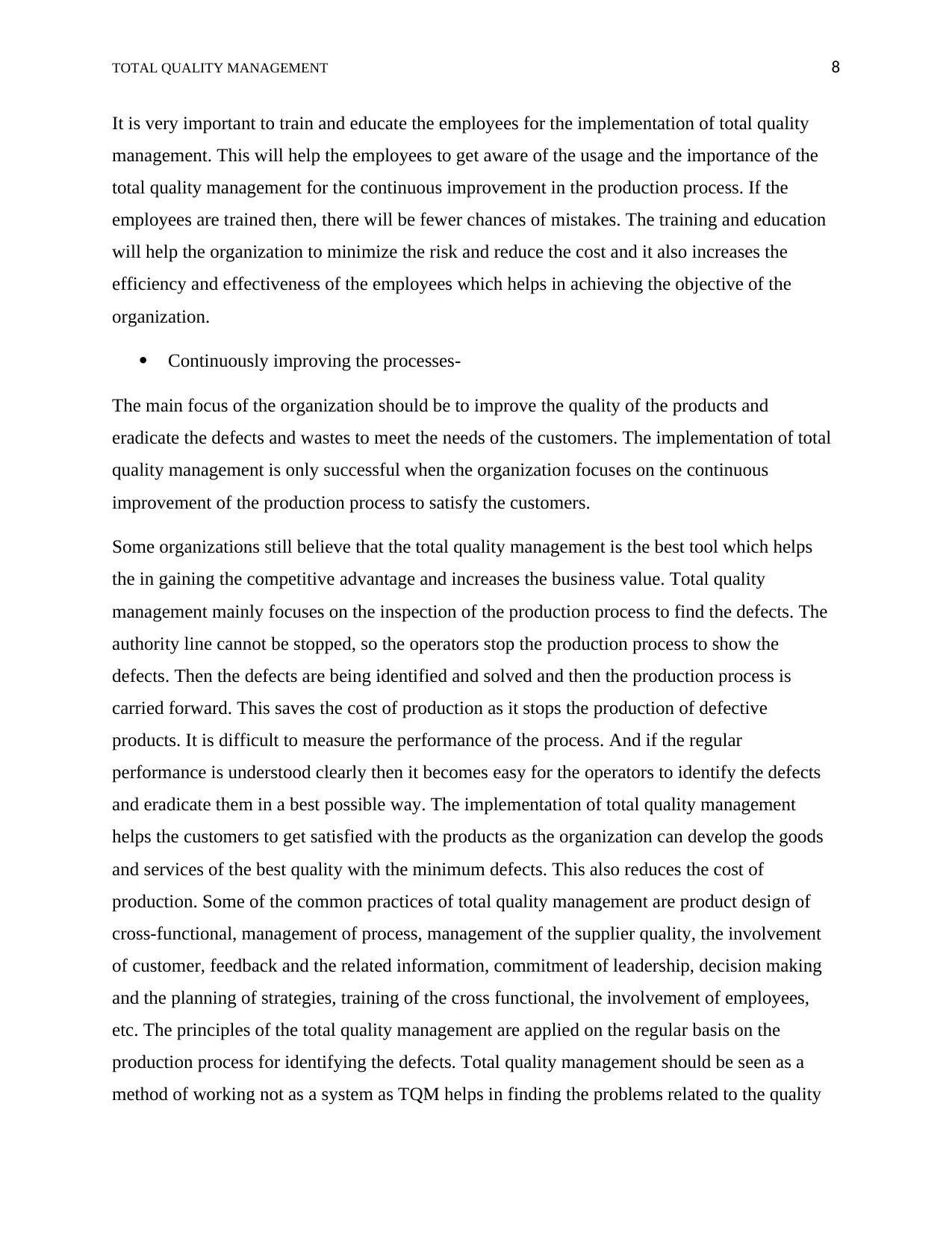
TOTAL QUALITY MANAGEMENT 8
It is very important to train and educate the employees for the implementation of total quality
management. This will help the employees to get aware of the usage and the importance of the
total quality management for the continuous improvement in the production process. If the
employees are trained then, there will be fewer chances of mistakes. The training and education
will help the organization to minimize the risk and reduce the cost and it also increases the
efficiency and effectiveness of the employees which helps in achieving the objective of the
organization.
Continuously improving the processes-
The main focus of the organization should be to improve the quality of the products and
eradicate the defects and wastes to meet the needs of the customers. The implementation of total
quality management is only successful when the organization focuses on the continuous
improvement of the production process to satisfy the customers.
Some organizations still believe that the total quality management is the best tool which helps
the in gaining the competitive advantage and increases the business value. Total quality
management mainly focuses on the inspection of the production process to find the defects. The
authority line cannot be stopped, so the operators stop the production process to show the
defects. Then the defects are being identified and solved and then the production process is
carried forward. This saves the cost of production as it stops the production of defective
products. It is difficult to measure the performance of the process. And if the regular
performance is understood clearly then it becomes easy for the operators to identify the defects
and eradicate them in a best possible way. The implementation of total quality management
helps the customers to get satisfied with the products as the organization can develop the goods
and services of the best quality with the minimum defects. This also reduces the cost of
production. Some of the common practices of total quality management are product design of
cross-functional, management of process, management of the supplier quality, the involvement
of customer, feedback and the related information, commitment of leadership, decision making
and the planning of strategies, training of the cross functional, the involvement of employees,
etc. The principles of the total quality management are applied on the regular basis on the
production process for identifying the defects. Total quality management should be seen as a
method of working not as a system as TQM helps in finding the problems related to the quality
It is very important to train and educate the employees for the implementation of total quality
management. This will help the employees to get aware of the usage and the importance of the
total quality management for the continuous improvement in the production process. If the
employees are trained then, there will be fewer chances of mistakes. The training and education
will help the organization to minimize the risk and reduce the cost and it also increases the
efficiency and effectiveness of the employees which helps in achieving the objective of the
organization.
Continuously improving the processes-
The main focus of the organization should be to improve the quality of the products and
eradicate the defects and wastes to meet the needs of the customers. The implementation of total
quality management is only successful when the organization focuses on the continuous
improvement of the production process to satisfy the customers.
Some organizations still believe that the total quality management is the best tool which helps
the in gaining the competitive advantage and increases the business value. Total quality
management mainly focuses on the inspection of the production process to find the defects. The
authority line cannot be stopped, so the operators stop the production process to show the
defects. Then the defects are being identified and solved and then the production process is
carried forward. This saves the cost of production as it stops the production of defective
products. It is difficult to measure the performance of the process. And if the regular
performance is understood clearly then it becomes easy for the operators to identify the defects
and eradicate them in a best possible way. The implementation of total quality management
helps the customers to get satisfied with the products as the organization can develop the goods
and services of the best quality with the minimum defects. This also reduces the cost of
production. Some of the common practices of total quality management are product design of
cross-functional, management of process, management of the supplier quality, the involvement
of customer, feedback and the related information, commitment of leadership, decision making
and the planning of strategies, training of the cross functional, the involvement of employees,
etc. The principles of the total quality management are applied on the regular basis on the
production process for identifying the defects. Total quality management should be seen as a
method of working not as a system as TQM helps in finding the problems related to the quality
⊘ This is a preview!⊘
Do you want full access?
Subscribe today to unlock all pages.

Trusted by 1+ million students worldwide
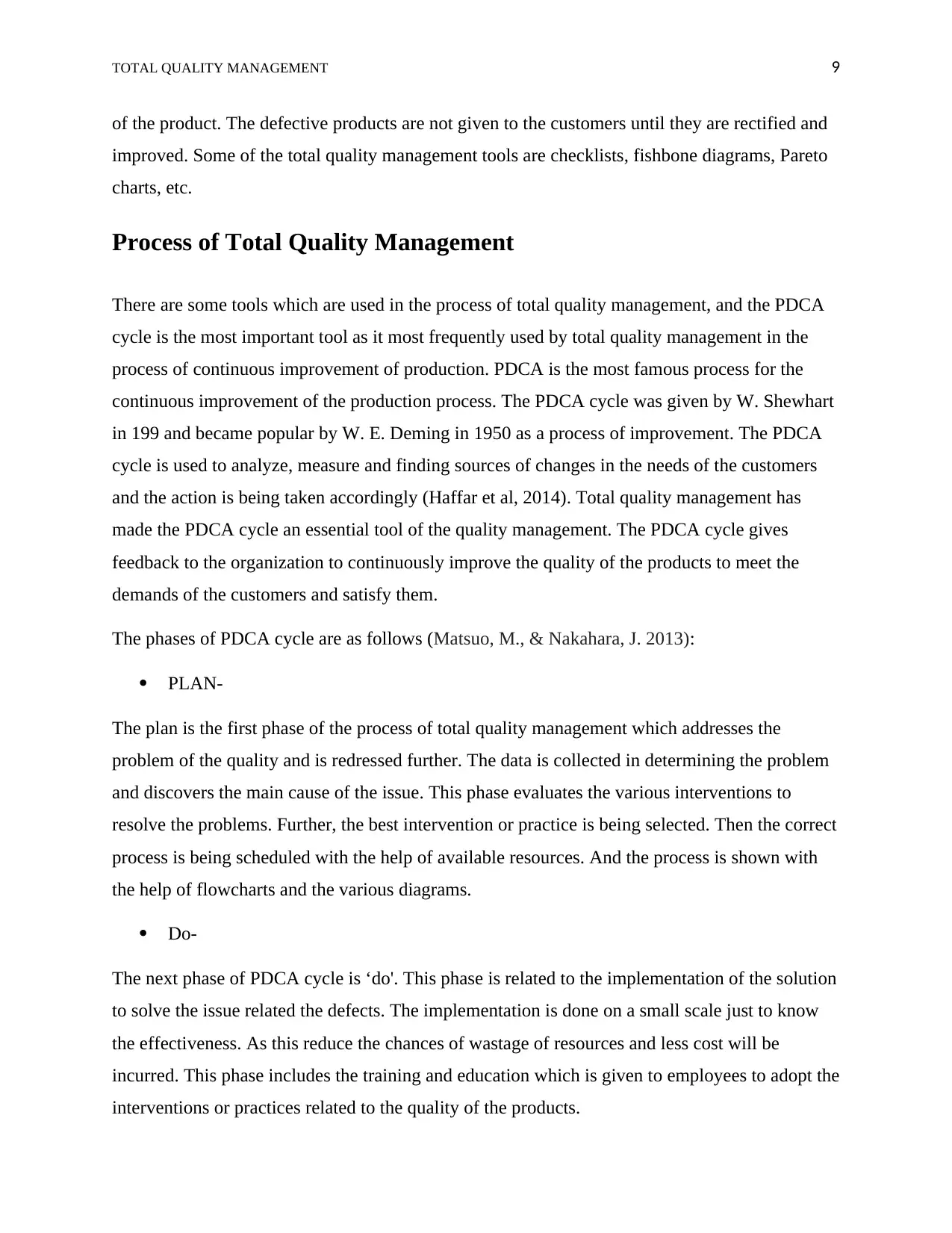
TOTAL QUALITY MANAGEMENT 9
of the product. The defective products are not given to the customers until they are rectified and
improved. Some of the total quality management tools are checklists, fishbone diagrams, Pareto
charts, etc.
Process of Total Quality Management
There are some tools which are used in the process of total quality management, and the PDCA
cycle is the most important tool as it most frequently used by total quality management in the
process of continuous improvement of production. PDCA is the most famous process for the
continuous improvement of the production process. The PDCA cycle was given by W. Shewhart
in 199 and became popular by W. E. Deming in 1950 as a process of improvement. The PDCA
cycle is used to analyze, measure and finding sources of changes in the needs of the customers
and the action is being taken accordingly (Haffar et al, 2014). Total quality management has
made the PDCA cycle an essential tool of the quality management. The PDCA cycle gives
feedback to the organization to continuously improve the quality of the products to meet the
demands of the customers and satisfy them.
The phases of PDCA cycle are as follows (Matsuo, M., & Nakahara, J. 2013):
PLAN-
The plan is the first phase of the process of total quality management which addresses the
problem of the quality and is redressed further. The data is collected in determining the problem
and discovers the main cause of the issue. This phase evaluates the various interventions to
resolve the problems. Further, the best intervention or practice is being selected. Then the correct
process is being scheduled with the help of available resources. And the process is shown with
the help of flowcharts and the various diagrams.
Do-
The next phase of PDCA cycle is ‘do'. This phase is related to the implementation of the solution
to solve the issue related the defects. The implementation is done on a small scale just to know
the effectiveness. As this reduce the chances of wastage of resources and less cost will be
incurred. This phase includes the training and education which is given to employees to adopt the
interventions or practices related to the quality of the products.
of the product. The defective products are not given to the customers until they are rectified and
improved. Some of the total quality management tools are checklists, fishbone diagrams, Pareto
charts, etc.
Process of Total Quality Management
There are some tools which are used in the process of total quality management, and the PDCA
cycle is the most important tool as it most frequently used by total quality management in the
process of continuous improvement of production. PDCA is the most famous process for the
continuous improvement of the production process. The PDCA cycle was given by W. Shewhart
in 199 and became popular by W. E. Deming in 1950 as a process of improvement. The PDCA
cycle is used to analyze, measure and finding sources of changes in the needs of the customers
and the action is being taken accordingly (Haffar et al, 2014). Total quality management has
made the PDCA cycle an essential tool of the quality management. The PDCA cycle gives
feedback to the organization to continuously improve the quality of the products to meet the
demands of the customers and satisfy them.
The phases of PDCA cycle are as follows (Matsuo, M., & Nakahara, J. 2013):
PLAN-
The plan is the first phase of the process of total quality management which addresses the
problem of the quality and is redressed further. The data is collected in determining the problem
and discovers the main cause of the issue. This phase evaluates the various interventions to
resolve the problems. Further, the best intervention or practice is being selected. Then the correct
process is being scheduled with the help of available resources. And the process is shown with
the help of flowcharts and the various diagrams.
Do-
The next phase of PDCA cycle is ‘do'. This phase is related to the implementation of the solution
to solve the issue related the defects. The implementation is done on a small scale just to know
the effectiveness. As this reduce the chances of wastage of resources and less cost will be
incurred. This phase includes the training and education which is given to employees to adopt the
interventions or practices related to the quality of the products.
Paraphrase This Document
Need a fresh take? Get an instant paraphrase of this document with our AI Paraphraser
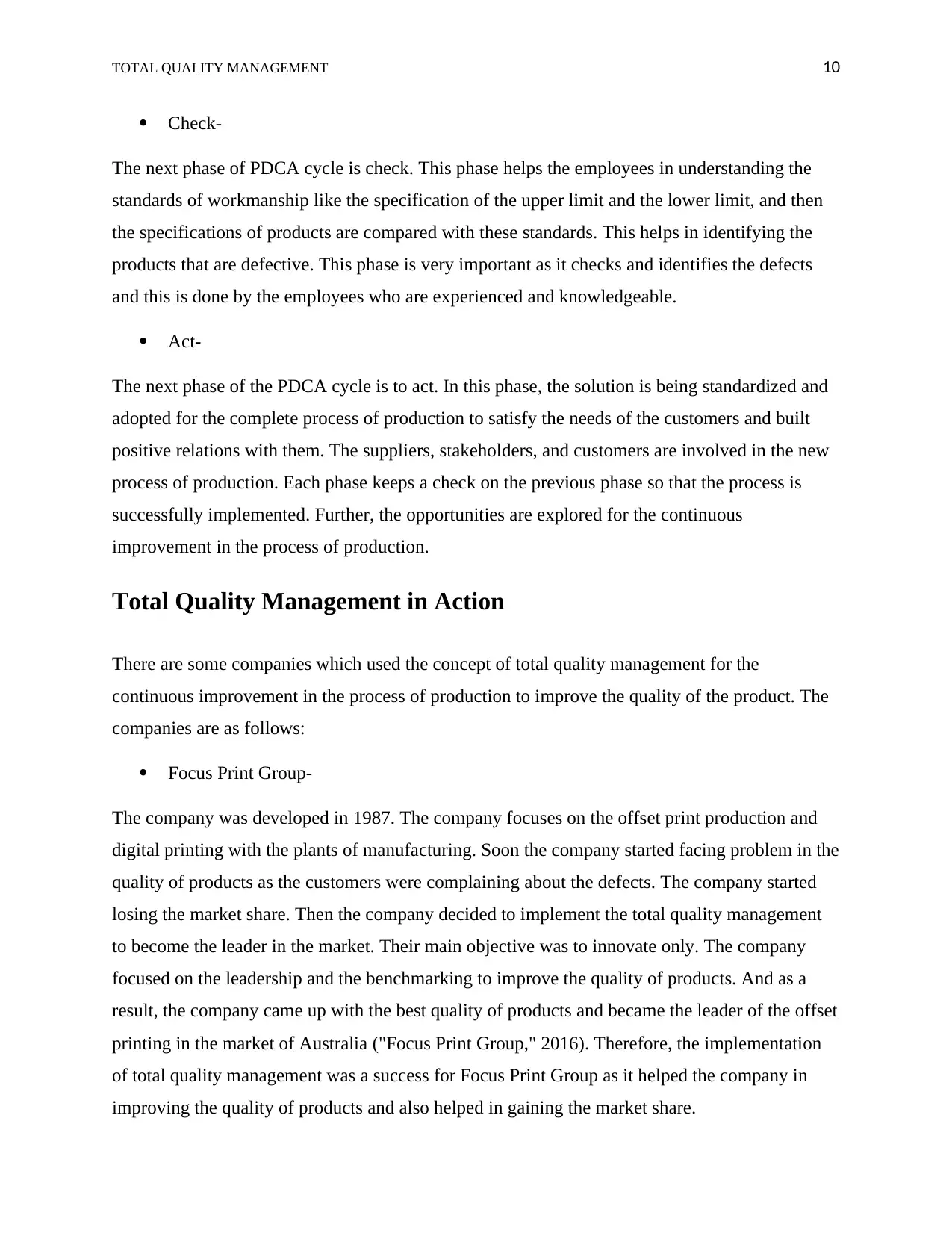
TOTAL QUALITY MANAGEMENT 10
Check-
The next phase of PDCA cycle is check. This phase helps the employees in understanding the
standards of workmanship like the specification of the upper limit and the lower limit, and then
the specifications of products are compared with these standards. This helps in identifying the
products that are defective. This phase is very important as it checks and identifies the defects
and this is done by the employees who are experienced and knowledgeable.
Act-
The next phase of the PDCA cycle is to act. In this phase, the solution is being standardized and
adopted for the complete process of production to satisfy the needs of the customers and built
positive relations with them. The suppliers, stakeholders, and customers are involved in the new
process of production. Each phase keeps a check on the previous phase so that the process is
successfully implemented. Further, the opportunities are explored for the continuous
improvement in the process of production.
Total Quality Management in Action
There are some companies which used the concept of total quality management for the
continuous improvement in the process of production to improve the quality of the product. The
companies are as follows:
Focus Print Group-
The company was developed in 1987. The company focuses on the offset print production and
digital printing with the plants of manufacturing. Soon the company started facing problem in the
quality of products as the customers were complaining about the defects. The company started
losing the market share. Then the company decided to implement the total quality management
to become the leader in the market. Their main objective was to innovate only. The company
focused on the leadership and the benchmarking to improve the quality of products. And as a
result, the company came up with the best quality of products and became the leader of the offset
printing in the market of Australia ("Focus Print Group," 2016). Therefore, the implementation
of total quality management was a success for Focus Print Group as it helped the company in
improving the quality of products and also helped in gaining the market share.
Check-
The next phase of PDCA cycle is check. This phase helps the employees in understanding the
standards of workmanship like the specification of the upper limit and the lower limit, and then
the specifications of products are compared with these standards. This helps in identifying the
products that are defective. This phase is very important as it checks and identifies the defects
and this is done by the employees who are experienced and knowledgeable.
Act-
The next phase of the PDCA cycle is to act. In this phase, the solution is being standardized and
adopted for the complete process of production to satisfy the needs of the customers and built
positive relations with them. The suppliers, stakeholders, and customers are involved in the new
process of production. Each phase keeps a check on the previous phase so that the process is
successfully implemented. Further, the opportunities are explored for the continuous
improvement in the process of production.
Total Quality Management in Action
There are some companies which used the concept of total quality management for the
continuous improvement in the process of production to improve the quality of the product. The
companies are as follows:
Focus Print Group-
The company was developed in 1987. The company focuses on the offset print production and
digital printing with the plants of manufacturing. Soon the company started facing problem in the
quality of products as the customers were complaining about the defects. The company started
losing the market share. Then the company decided to implement the total quality management
to become the leader in the market. Their main objective was to innovate only. The company
focused on the leadership and the benchmarking to improve the quality of products. And as a
result, the company came up with the best quality of products and became the leader of the offset
printing in the market of Australia ("Focus Print Group," 2016). Therefore, the implementation
of total quality management was a success for Focus Print Group as it helped the company in
improving the quality of products and also helped in gaining the market share.
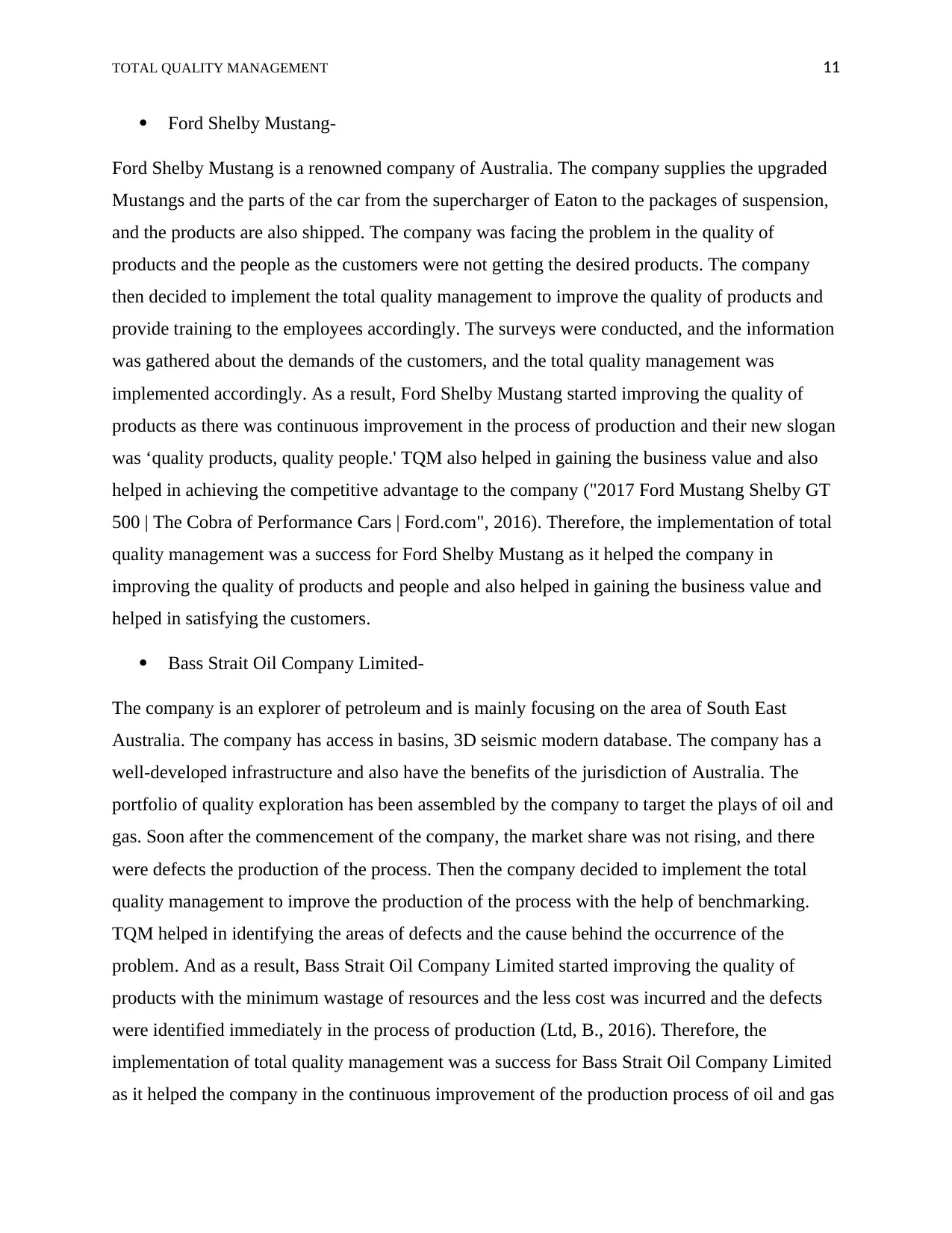
TOTAL QUALITY MANAGEMENT 11
Ford Shelby Mustang-
Ford Shelby Mustang is a renowned company of Australia. The company supplies the upgraded
Mustangs and the parts of the car from the supercharger of Eaton to the packages of suspension,
and the products are also shipped. The company was facing the problem in the quality of
products and the people as the customers were not getting the desired products. The company
then decided to implement the total quality management to improve the quality of products and
provide training to the employees accordingly. The surveys were conducted, and the information
was gathered about the demands of the customers, and the total quality management was
implemented accordingly. As a result, Ford Shelby Mustang started improving the quality of
products as there was continuous improvement in the process of production and their new slogan
was ‘quality products, quality people.' TQM also helped in gaining the business value and also
helped in achieving the competitive advantage to the company ("2017 Ford Mustang Shelby GT
500 | The Cobra of Performance Cars | Ford.com", 2016). Therefore, the implementation of total
quality management was a success for Ford Shelby Mustang as it helped the company in
improving the quality of products and people and also helped in gaining the business value and
helped in satisfying the customers.
Bass Strait Oil Company Limited-
The company is an explorer of petroleum and is mainly focusing on the area of South East
Australia. The company has access in basins, 3D seismic modern database. The company has a
well-developed infrastructure and also have the benefits of the jurisdiction of Australia. The
portfolio of quality exploration has been assembled by the company to target the plays of oil and
gas. Soon after the commencement of the company, the market share was not rising, and there
were defects the production of the process. Then the company decided to implement the total
quality management to improve the production of the process with the help of benchmarking.
TQM helped in identifying the areas of defects and the cause behind the occurrence of the
problem. And as a result, Bass Strait Oil Company Limited started improving the quality of
products with the minimum wastage of resources and the less cost was incurred and the defects
were identified immediately in the process of production (Ltd, B., 2016). Therefore, the
implementation of total quality management was a success for Bass Strait Oil Company Limited
as it helped the company in the continuous improvement of the production process of oil and gas
Ford Shelby Mustang-
Ford Shelby Mustang is a renowned company of Australia. The company supplies the upgraded
Mustangs and the parts of the car from the supercharger of Eaton to the packages of suspension,
and the products are also shipped. The company was facing the problem in the quality of
products and the people as the customers were not getting the desired products. The company
then decided to implement the total quality management to improve the quality of products and
provide training to the employees accordingly. The surveys were conducted, and the information
was gathered about the demands of the customers, and the total quality management was
implemented accordingly. As a result, Ford Shelby Mustang started improving the quality of
products as there was continuous improvement in the process of production and their new slogan
was ‘quality products, quality people.' TQM also helped in gaining the business value and also
helped in achieving the competitive advantage to the company ("2017 Ford Mustang Shelby GT
500 | The Cobra of Performance Cars | Ford.com", 2016). Therefore, the implementation of total
quality management was a success for Ford Shelby Mustang as it helped the company in
improving the quality of products and people and also helped in gaining the business value and
helped in satisfying the customers.
Bass Strait Oil Company Limited-
The company is an explorer of petroleum and is mainly focusing on the area of South East
Australia. The company has access in basins, 3D seismic modern database. The company has a
well-developed infrastructure and also have the benefits of the jurisdiction of Australia. The
portfolio of quality exploration has been assembled by the company to target the plays of oil and
gas. Soon after the commencement of the company, the market share was not rising, and there
were defects the production of the process. Then the company decided to implement the total
quality management to improve the production of the process with the help of benchmarking.
TQM helped in identifying the areas of defects and the cause behind the occurrence of the
problem. And as a result, Bass Strait Oil Company Limited started improving the quality of
products with the minimum wastage of resources and the less cost was incurred and the defects
were identified immediately in the process of production (Ltd, B., 2016). Therefore, the
implementation of total quality management was a success for Bass Strait Oil Company Limited
as it helped the company in the continuous improvement of the production process of oil and gas
⊘ This is a preview!⊘
Do you want full access?
Subscribe today to unlock all pages.

Trusted by 1+ million students worldwide
1 out of 18
Related Documents
Your All-in-One AI-Powered Toolkit for Academic Success.
+13062052269
info@desklib.com
Available 24*7 on WhatsApp / Email
![[object Object]](/_next/static/media/star-bottom.7253800d.svg)
Unlock your academic potential
Copyright © 2020–2025 A2Z Services. All Rights Reserved. Developed and managed by ZUCOL.




